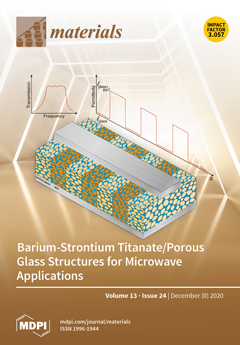CaCu
3Ti
4-x((A
0.05Nb
0.05))
xO
12 ceramics (A: Al and Bi; x = 0, 0.3) were synthesized by high-energy mechanical ball milling and reactive sintering at 1050 °C in air. Rietveld refinement of XRD data revealed the pure and (Al
3+, Nb
5+) cosubstituted ceramics contained a minor CuO secondary phase with a mole fraction of about 3.2% and 6.9%, respectively, along with a CaCu
3Ti
4O
12 (CCTO)-like cubic structure. In addition, (Bi
3+, Nb
5+) cosubstituted ceramics had a pyrochlore (Ca
2(Ti, Nb)
2O
7) secondary phase of about 18%. While the (Al
3+, Nb
5+) cosubstituted CCTO showed the highest relative permittivity (ε’ = 3.9 × 10
4), pure CCTO showed the lowest dielectric loss (tanδ = 0.023) at 1 kHz and 300 K. Impedance-spectroscopy (IS) measurements showed an electrically heterogeneous structure for the studied ceramics, where a semiconducting grain was surrounded by highly resistive grain boundary. The giant relative permittivity of the ceramics was attributed to the Maxwell–Wagner polarization effect at the blocking grain boundaries and domain boundaries. The higher tanδ of the cosubstituted samples was correlated with their lower grain boundary’s resistivity, as confirmed by IS analysis. Modulus-spectrum analysis revealed two relaxation processes for the pure and (Bi
3+, Nb
5+) cosubstituted CCTO samples. Dissimilar behavior was observed for the (Al
3+, Nb
5+) cosubstituted CCTO, where three relaxation mechanisms were observed and attributed to the grain, domain-boundary, and grain-boundary responses.
Full article






